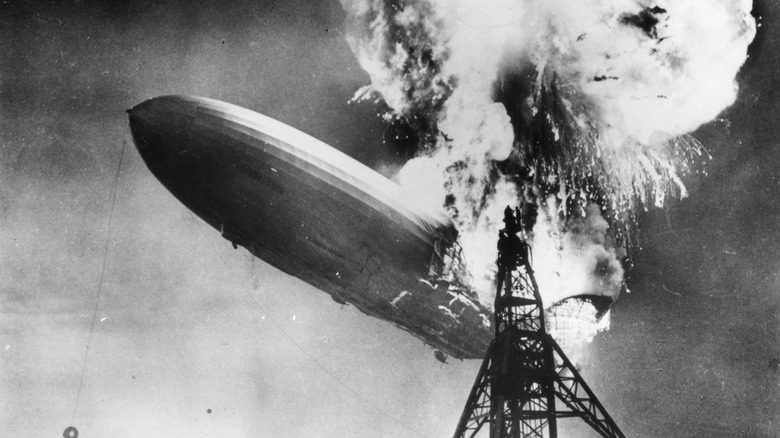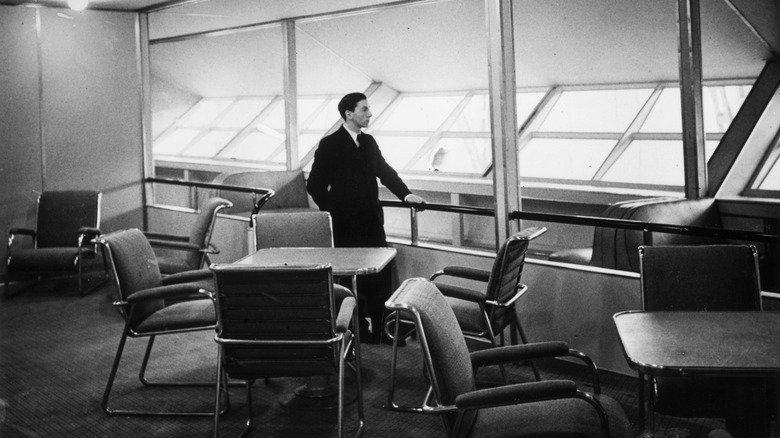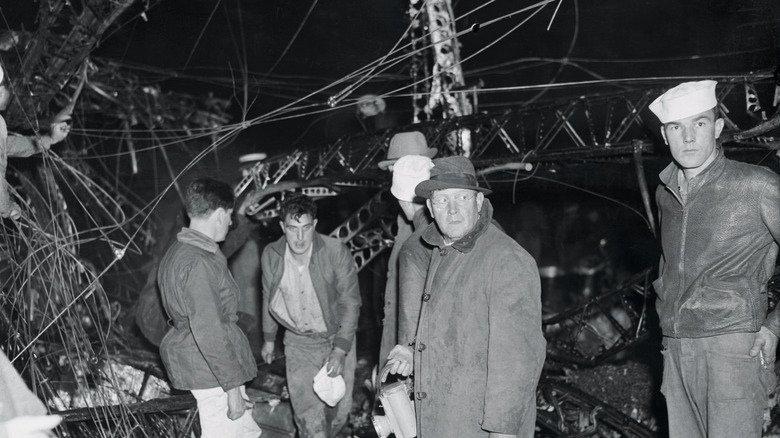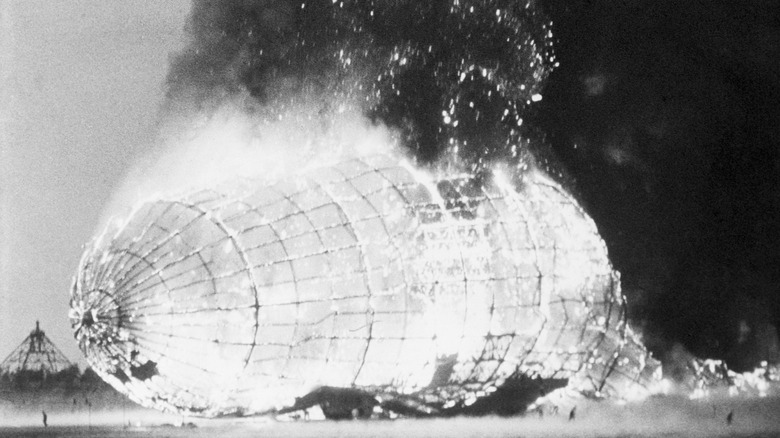How Many People Died In The Hindenburg Disaster?
On the evening of May 6, 1937, the Zeppelin LZ 129 Hindenburg arrived at Lakehurst Naval Air Station in Eastern New Jersey after its first Atlantic crossing from Germany that year. Elizabeth Ballentine watched the huge airship cruise around the field waiting for the weather to clear before it started to dock at its mooring mast. The rear of the dirigible suddenly began to glow eerily as if the steel ribs had been electrified. Seconds later the Zeppelin burst into flames.
"It looked like a huge cigar with the end glowing," Ballentine later told the Courier-Post. She and everyone else took off running amid the searing heat from the explosion. "We did not look back," she continued. "We were sure that everyone in the ship and on the ground crew was being roasted alive." Ballentine's assessment, surprisingly, was off the mark. Of the 97 people aboard, 35 perished in this disaster that sounded the death knell for commercial airship travel. Of the 231 members of the ground crew, only one perished. Even so, it remains one of the worst airship accidents in history.
First-hand accounts
Traveling on the Hindenburg was the height of luxury. The airship was spacious and included amenities like a dining room with hand-painted silk wallpaper, a lounge, two decks for sightseeing, and a bar, among other amenities. The Zeppelin was also the fastest way to cross the Atlantic for civilian passengers since the first commercial airline didn't begin until 1939. Herbert O'Laughlin, a passenger on the Zeppelin, was packing his bags when he felt "a slight tremor," which turned out to be the first of three explosions that tore the Hindenburg apart (via The Buffalo News).
O'Laughlin, who was at the front of the Hindenburg, didn't initially realize what it was. When he did, he prepared to jump from a window but was instead tossed from the Zeppelin in the next explosion. He landed unhurt and helped put out the Hindenburg's former captain, Ernst Lehmann, who was on fire. On the ground, Edward Giles, one of the ground crew, watched in horror as people began jumping from the Hindenburg while others were blown through the sides of the airship. "The shrieks from within the wreckage rose above the roar of burning fabric," he recalled in a United Press story.
Hindenburg's former captain was killed
The day after the disaster, Capt. Ernst Lehmann lay in bed at the Paul Kimball Hospital in Lakewood. He'd been badly burned but remained steadfast in his belief that he would survive to one day helm another Zeppelin. "I'm going to make it," he told the doctors (via the Associated Press). "I'll be alright." He'd been on the Hindenburg in an advisory capacity during the trip and stayed inside as long as possible, attempting to help land it. Finally, as the fire overtook him, Lehmann leaped out of the Zeppelin, his clothes aflame. Just before he died he muttered his final words from between "burn-swollen lips" wondering "how it happened," according to a separate Associated Press story.
The answer to that question revolved around the flammable hydrogen gas used in the Hindenburg instead of helium. The U.S. had a monopoly on helium and had banned its sale to Nazi Germany. U.S. Officials determined the cause of the disaster was "a combustible mixture of hydrogen and air ... in the upper stern part of the ship in considerable quantity" that had been ignited by atmospheric electricity (via airships.net). There were also rumors the explosion stemmed from sabotage against the Nazis. No matter the true cause of the Hindenburg disaster, the results were devastating for the passengers, crew, and families of the dead and dying.
The Hindenburg's dead
The dead from the Hindenburg disaster included a broad range of ages and backgrounds. Of the 13 dead passengers, there was Ernst Anders, who was on his way to meet the governor of New Jersey about an upcoming Swedish-American celebration; a druggist from Mexico City and his 14-year-old daughter; and Edward Douglas, 39, an advertising man whose brother, a local reporter, was there covering the airship's arrival. Alan Hagaman, who was incinerated under the Zeppelin, was the sole member of the ground crew to die.
Besides Captain Lehmann, 21 other crew members of the Hindenburg also died. Capt. Max Pruss, who had taken command of the airship from Ernst Lehmann in September 1936, survived but was badly burned and carried the scars from the accident for the rest of his life. The rise and fall of the Hindenburg had been swift. The airship made its inaugural flight from Frankfort, Germany to Lakehurst, New Jersey, on May 6, 1936, a year to the day of the disaster. It made 10 trips to the U.S. in 1936 without incident until its fatal end.



